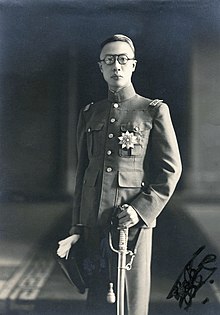
Back Puyi Afrikaans Hsuan-tung Cāsere ANG بوئي Arabic بوئى ARZ Puyi AST پویی AZB Пу И Bashkir Пу И Bulgarian ཕུ་ཡི། Tibetan Pu Yi Catalan
| Puyi 溥儀 | |||||||||||||||||||||
|---|---|---|---|---|---|---|---|---|---|---|---|---|---|---|---|---|---|---|---|---|---|
 Portrait of Puyi, c. 1930s–1940s | |||||||||||||||||||||
| Emperor of the Qing dynasty | |||||||||||||||||||||
| First reign | 2 December 1908 – 12 February 1912 | ||||||||||||||||||||
| Predecessor | Guangxu Emperor | ||||||||||||||||||||
| Successor | Monarchy abolished | ||||||||||||||||||||
| Regents |
| ||||||||||||||||||||
| Prime Ministers | |||||||||||||||||||||
| Second reign | 1 July 1917 – 12 July 1917[a] | ||||||||||||||||||||
| Prime minister | Zhang Xun | ||||||||||||||||||||
| Emperor of Manchukuo | |||||||||||||||||||||
| Reign | 1 March 1934 – 17 August 1945 | ||||||||||||||||||||
| Predecessor | Himself as Chief Executive of Manchukuo | ||||||||||||||||||||
| Successor | Position abolished | ||||||||||||||||||||
| Prime Minister | |||||||||||||||||||||
| Chief Executive of Manchukuo | |||||||||||||||||||||
| In office | 18 February 1932 – 28 February 1934 | ||||||||||||||||||||
| Predecessor | Position established | ||||||||||||||||||||
| Successor | Himself as Emperor | ||||||||||||||||||||
| Prime Minister | Zheng Xiaoxu | ||||||||||||||||||||
| Born | 7 February 1906 Prince Chun Mansion, Beijing, Qing China | ||||||||||||||||||||
| Died | 17 October 1967 (aged 61) Peking Union Medical College Hospital, Beijing, People's Republic of China | ||||||||||||||||||||
| Burial | Babaoshan Revolutionary Cemetery, later reburied in the Hualong Imperial Cemetery, Yi County, Hebei | ||||||||||||||||||||
| Consorts | |||||||||||||||||||||
| |||||||||||||||||||||
| House | Aisin Gioro | ||||||||||||||||||||
| Dynasty | |||||||||||||||||||||
| Father | Zaifeng, Prince Chun | ||||||||||||||||||||
| Mother | Gūwalgiya Youlan (biological) Empress Xiaodingjing (adoptive) Wang Lianshou (adoptive) | ||||||||||||||||||||
| Seal[b] |  | ||||||||||||||||||||
| Chinese name | |||||||||||||||||||||
| Traditional Chinese | 溥儀 | ||||||||||||||||||||
| Simplified Chinese | 溥仪 | ||||||||||||||||||||
| |||||||||||||||||||||
| Xuantong Emperor | |||||||||||||||||||||
| Traditional Chinese | 宣統帝 | ||||||||||||||||||||
| Simplified Chinese | 宣统帝 | ||||||||||||||||||||
| |||||||||||||||||||||
Puyi[c] (7 February 1906 – 17 October 1967) was the final emperor of China, reigning as the eleventh and final monarch of the Qing dynasty. He became emperor at the age of two in 1908, but was forced to abdicate in 1912 as a result of Xinhai Revolution at the age of six. During his first reign, he was known as the Xuantong Emperor, with his era name meaning "proclamation of unity".
Puyi was briefly restored to the Qing throne by the loyalist general Zhang Xun from 1 July to 12 July 1917. He was first wed to Empress Wanrong in 1922 in an arranged marriage. In 1924, he was expelled from the Forbidden City and found refuge in Tianjin, where he began to court both the warlords fighting for control over parts of the weak Republic of China and the Japanese who had long desired control of China. The Japanese invasion of Manchuria in 1932 resulted in the puppet state of Manchukuo being established by Japan, who chose Puyi to become its chief executive, using the era name "Datong".
In 1934, he was declared emperor of Manchukuo, prompting writer Wen Yuan-ning to quip that Puyi "holds the world's record for the number of times that any mortal may ascend and abdicate the throne."[1] Puyi nominally reigned under the era name "Kangde" until the end of the Second Sino-Japanese War in 1945. This third stint as emperor saw him as a puppet of Japan; he signed most edicts the Japanese gave him. During this period, he largely resided in the Salt Tax Palace, where he regularly ordered his servants beaten. His first wife's opium addiction consumed her during these years, and they were generally distant. He took on numerous concubines, as well as male lovers. With the surrender of Japan in 1945, Puyi fled the capital and was eventually captured by the Soviets who had occupied the country; he was extradited to the People's Republic of China in 1950. After his capture, he never saw his first wife again; she died of starvation in a Chinese prison in 1946.
Puyi was a defendant at the Tokyo Trials and was later imprisoned and re-educated as a war criminal for 10 years. After his release in 1959, he wrote his memoirs (with the help of a ghostwriter) and became a titular member of the Chinese People's Political Consultative Conference and the National People's Congress of the People's Republic of China. His time in prison greatly changed him, and he expressed deep regret for his actions while he was emperor. He died in 1967 and was ultimately buried near the Western Qing tombs in a commercial cemetery.
Cite error: There are <ref group=lower-alpha> tags or {{efn}} templates on this page, but the references will not show without a {{reflist|group=lower-alpha}} template or {{notelist}} template (see the help page).
- ^ Wen, Yuan-ning (2018). "Emperor Malgre Lui" (Feb. 8, 1934), in Imperfect Understanding: Intimate Portraits of Modern Chinese Celebrities. Cambria Press. p. 117.
© MMXXIII Rich X Search. We shall prevail. All rights reserved. Rich X Search